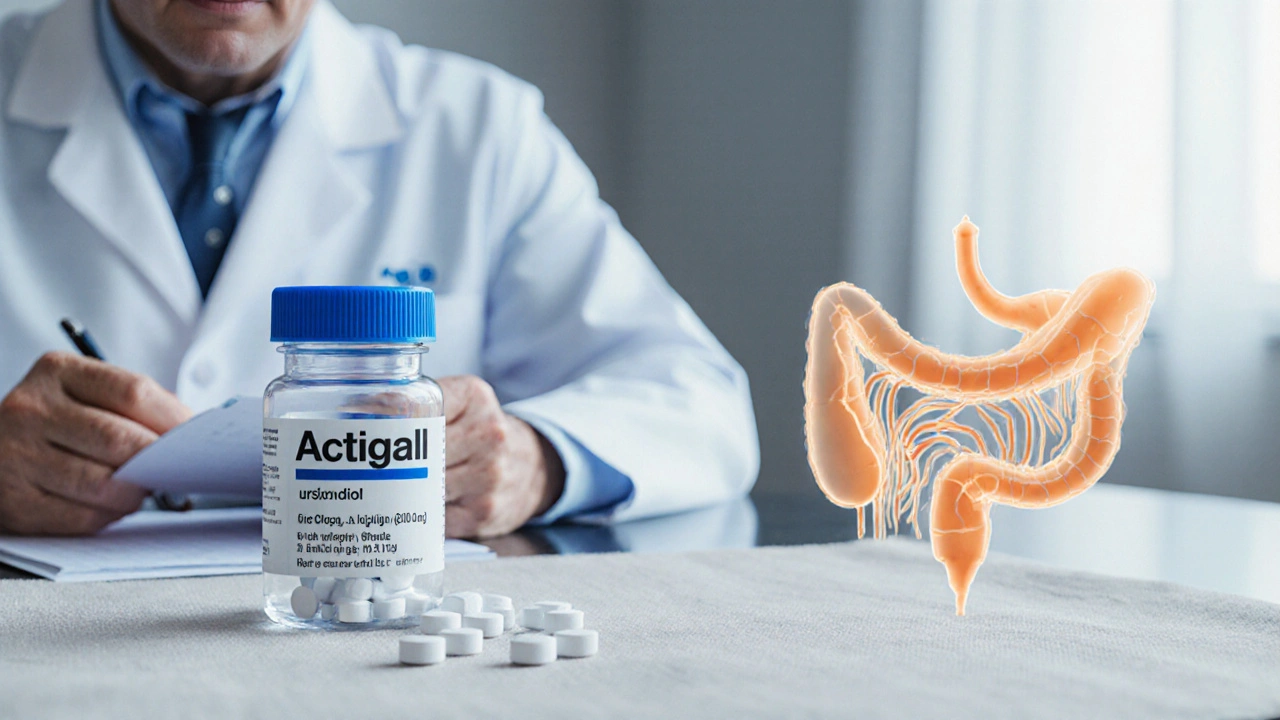Actigall vs Alternatives Comparison Tool
Comparison Summary
Actigall: Gallstone dissolution, Primary biliary cholangitis
Chenodeoxycholic acid: Gallstone dissolution (off-label)
Obeticholic acid: PBC in patients with inadequate response to ursodiol
Cholestyramine: Pruritus and hypercholesterolemia
Actigall: Reduces cholesterol saturation in bile; protects cholangiocytes
Chenodeoxycholic acid: Increases bile-acid pool; may cause cholestasis at high dose
Obeticholic acid: FXR agonist → ↓ bile-acid synthesis
Cholestyramine: Ion-exchange resin binds bile acids in gut
Actigall: 8-10 mg/kg BID (gallstones); 13-15 mg/kg QD (PBC)
Chenodeoxycholic acid: 10-15 mg/kg BID
Obeticholic acid: 5-10 mg daily
Cholestyramine: 4 g QD, up to 16 g/day
Actigall: 30-50% of suitable stones dissolve
Chenodeoxycholic acid: Similar to ursodiol but higher hepatotoxic risk
Obeticholic acid: Not used for stones
Cholestyramine: Not used for stones
Actigall: Diarrhea, nausea, abdominal pain
Chenodeoxycholic acid: Liver enzyme elevation, diarrhea
Obeticholic acid: Pruritus, ↑ LDL-C
Cholestyramine: Constipation, vitamin malabsorption
Actigall: $150-$250 (brand) / $30-$60 (generic)
Chenodeoxycholic acid: $200-$300 (off-label)
Obeticholic acid: $300-$400
Cholestyramine: $20-$40
Decision Points
- Diagnosis: Gallstones vs. PBC
- Stone size and composition: Only cholesterol stones under 15 mm respond to bile-acid therapy
- Liver function: Elevated transaminases may exclude CDCA due to hepatotoxicity
- Side-effect tolerance: Consider pruritus with obeticholic acid, constipation with cholestyramine
- Cost and insurance: Generic ursodiol is most affordable; obeticholic acid requires prior authorization
When doctors prescribe a bile‑acid pill for gallstone dissolution or liver‑related cholestasis, Actigall often tops the list. But it’s not the only option on the market, and the right choice depends on the condition you’re treating, how you tolerate side effects, and even the price tag. Below you’ll find a step‑by‑step look at what Actigall actually does, which alternatives exist, and a side‑by‑side comparison that lets you weigh the pros and cons in plain language.
What is Actigall (Ursodiol) and when is it used?
Actigall is the brand name for ursodeoxycholic acid, a naturally occurring bile acid found in small amounts in human bile. Ursodiol works by reducing the cholesterol content of bile and by enhancing the flow of bile through the liver and gallbladder. In clinical practice, it’s approved for two main indications: dissolving small, non‑calcified gallstones when surgery isn’t an option, and treating primary biliary cholangitis (PBC), a chronic autoimmune disease that damages the bile ducts.
Typical dosing for gallstone dissolution is 8-10mg per kilogram of body weight, taken in two divided doses. For PBC, the standard dose is 13‑15mg/kg once daily. The medication is taken orally, usually with meals, and therapy can last months to years depending on response.
Why look for alternatives?
Even though Actigall is effective for many patients, it isn’t a one‑size‑fits‑all solution. Common drawbacks include a modest dissolution rate (about 30‑50% of eligible stones dissolve), gastrointestinal upset, and a price that can be steep without insurance. Some people also have contraindications such as severe liver impairment or a history of allergic reactions to bile‑acid formulations.
Because of these limitations, clinicians and patients often explore other treatments-both pharmaceutical and non‑pharmaceutical. The most frequently mentioned alternatives are other bile‑acid agents, a bile‑acid sequestrant, and lifestyle‑based approaches. Below we break each one down.
Key alternatives to Actigall
- Chenodeoxycholic acid (CDCA) - another primary bile acid that can dissolve cholesterol stones and improve bile flow. It’s less commonly prescribed in the U.S. due to hepatotoxicity concerns at high doses.
- Obeticholic acid - a semi‑synthetic bile‑acid analog approved for PBC patients who respond inadequately to ursodiol. It works by activating the farnesoid X receptor (FXR) to reduce bile‑acid synthesis.
- Cholestyramine - a resin that binds bile acids in the intestine, used mainly for pruritus in cholestatic liver disease rather than stone dissolution.
- Non‑pharmacologic options - low‑fat diet, weight management, and, when feasible, laparoscopic cholecystectomy remain the gold standard for symptomatic gallstones.

Side‑effect profiles at a glance
Understanding tolerability helps narrow down the best fit. Below is a quick reference:
- Actigall (Ursodiol): mild diarrhea, nausea, abdominal cramping; rare liver enzyme elevation.
- Chenodeoxycholic acid: higher incidence of hepatotoxicity, especially if dose exceeds 15mg/kg; also causes diarrhea.
- Obeticholic acid: pruritus (itching) is common; can increase LDL cholesterol; monitor liver enzymes.
- Cholestyramine: constipation, bloating, interferes with absorption of fat‑soluble vitamins (A, D, E, K).
Side‑by‑side comparison table
| Attribute | Actigall (Ursodiol) | Chenodeoxycholic acid | Obeticholic acid | Cholestyramine |
|---|---|---|---|---|
| FDA approval | Gallstone dissolution, Primary biliary cholangitis | Gallstone dissolution (off‑label) | PBC in patients with inadequate response to ursodiol | Pruritus and hypercholesterolemia |
| Mechanism | Reduces cholesterol saturation in bile; protects cholangiocytes | Increases bile‑acid pool; may cause cholestasis at high dose | FXR agonist → ↓ bile‑acid synthesis | Ion‑exchange resin binds bile acids in gut |
| Typical dose | 8‑10mg/kg BID (gallstones); 13‑15mg/kg QD (PBC) | 10‑15mg/kg BID | 5‑10mg daily | 4g QD, up to 16g/day |
| Stone dissolution efficacy | 30‑50% of suitable stones | Similar to ursodiol but higher hepatotoxic risk | N/A (not used for stones) | N/A |
| Common side effects | Diarrhea, nausea, abdominal pain | Liver enzyme elevation, diarrhea | Pruritus, ↑ LDL‑C | Constipation, vitamin malabsorption |
| Approx. monthly cost (US) | $150‑$250 (brand) / $30‑$60 (generic) | $200‑$300 (off‑label) | $300‑$400 | $20‑$40 |
How to decide which option fits you
Picking a therapy isn’t just about the table numbers; it’s about your health story. Consider these decision points:
- Diagnosis: Are you dealing with gallstones that can be dissolved, or is the focus on a chronic liver disease like PBC? Actigall covers both, while obeticholic acid is PBC‑specific.
- Stone size and composition: Only cholesterol stones under 15mm and radiolucent on X‑ray respond well to bile‑acid therapy. If you have mixed or calcified stones, surgical removal is usually recommended.
- Liver function: Elevated baseline transaminases may steer you away from chenodeoxycholic acid because of its hepatotoxic potential.
- Side‑effect tolerance: If itching is a deal‑breaker, obeticholic acid may not be ideal. If you’re prone to constipation, cholestyramine could worsen the problem.
- Cost and insurance coverage: Generic ursodiol is the most affordable bile‑acid option. Some insurers consider obeticholic acid a specialty drug requiring prior authorization.
Bring this checklist to your next appointment; it shows you’ve done homework and helps the clinician tailor a plan.

Practical tips for taking Actigall and its alternatives
- Take the medication with food to improve absorption and reduce stomach upset.
- Never crush or chew tablets; they’re designed for slow release.
- For cholestyramine, separate dosing by at least 1hour from any other oral medication to avoid binding interactions.
- Monitor liver enzymes every 3-6months when on ursodiol or CDCA.
- Vitamin D and calcium supplements are advisable if you’re on cholestyramine long‑term.
When surgery becomes the better route
Even the best medication can’t replace the definitive solution for symptomatic stones that are too large, calcified, or causing recurrent biliary colic. Laparoscopic cholecystectomy has a >95% success rate and a short recovery time. If you’ve tried ursodiol for six months without adequate stone reduction, or if you develop complications like cholecystitis, talk to your surgeon about removal.
Frequently Asked Questions
Can Actigall dissolve all types of gallstones?
No. It works only on cholesterol‑rich, non‑calcified stones that are smaller than about 15mm. Pigment stones or large calcified stones usually require surgery.
Is generic ursodiol as effective as the brand name Actigall?
Clinical studies show bioequivalence between generic and brand formulations, so efficacy should be comparable. The main difference is cost.
What are the main reasons a doctor would switch me from Actigall to obeticholic acid?
If you have primary biliary cholangitis and your liver tests don’t improve after at least 12 months of ursodiol, or if you experience disease progression, the specialist may add or replace it with obeticholic acid.
Does cholestyramine help dissolve gallstones?
No. Cholestyramine sequesters bile acids to relieve itching in cholestasis; it actually reduces the bile‑acid pool and isn’t used for stone dissolution.
How long should I stay on Actigall if it’s working?
Treatment continues until imaging shows complete stone clearance, which can take 6-24 months, then a maintenance dose may be used to prevent recurrence.
Next steps for patients and caregivers
1. Review your latest imaging reports to confirm stone size and composition.
2. Check your medication list for potential interactions, especially if you’re on cholesterol‑lowering drugs or vitamin supplements.
3. Schedule a liver‑function panel if you haven’t had one in the past 3months.
4. Use the decision checklist above to talk with your clinician about the best therapeutic path-whether that’s continuing Actigall, trying an alternative, or planning surgery.
5. Keep a side‑effect diary. Simple notes like “day 3: mild nausea” help the doctor fine‑tune dosage or switch meds before problems become serious.
By matching your clinical picture with the strengths and limits of each option, you can move from guesswork to a clear, evidence‑based plan.


Graham Holborn
Hi, I'm Caspian Osterholm, a pharmaceutical expert with a passion for writing about medication and diseases. Through years of experience in the industry, I've developed a comprehensive understanding of various medications and their impact on health. I enjoy researching and sharing my knowledge with others, aiming to inform and educate people on the importance of pharmaceuticals in managing and treating different health conditions. My ultimate goal is to help people make informed decisions about their health and well-being.